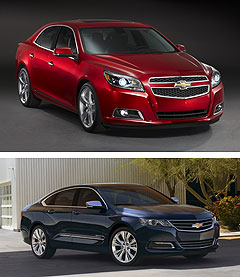Safety first for Chev Impala – and Commodore
BY RON HAMMERTON | 10th Jul 2012

Autonomous braking, rear cross traffic alert and full-speed adaptive cruise control are among 10 safety features that will grace the born-again front-drive Impala in a Chevrolet first in North America.
The gadget line-up was revealed by General Motors as a teaser for the new front-drive Impala that will make its showroom debut in the United States in the first quarter of next year – almost a year after the Impala concept was revealed at the New York motor show in April.
It is unclear which of the technologies will be standard across the Impala range or just offered on high-end models or only as extra-cost options, perhaps as part of a safety pack.
As well as safety technologies, the Commodore/SS and Impala will share a strong styling bond, with near-identical heavily sculpted bonnet lines, LED daytime running lights in the lower fascia and other cues placing both sedans squarely in the same Chevrolet family.

Similar styling language can be seen on the mid-sized 2013 Chevrolet Malibu that will be sold under Holden badges in the second half of next year, although the Malibu lacks the bonnet’s central “power bulge” that appears to be evident on Commodore test cars roaming Victorian roads.
The strong body lines might be more than skin deep, perhaps designed to give an aluminium bonnet more rigidity.
As GoAuto reported last month, Holden will dip into GM’s technology parts bin for new safety technologies, not only to lift the safety performance of its new-generation Commodore but to meet showroom expectation for the rear-drive Chevrolet SS that will sit alongside the Impala in North American showrooms.
Forward collision alert and side blind spot warning systems were known to be among the new features to make their Commodore debut on the VF, at least in some variants.
However, a list of available technologies might go much deeper, judging by the safety features set to debut on the new Impala which will set the large-car standard at Chevrolet, at least for high-end variants.
Apart from 10 airbags, the Impala gets a new-generation adaptive cruise control that not only locks on to a car in front and adjusts its speed accordingly, but also can go from a complete stop to full acceleration.
An autonomous braking system – called collision mitigation braking by GM – uses radar to detect a potential crash and, after alerting the driver, can automatically apply the brakes.
A separate forward collision alert, using a camera to detect a crash threat and warn the driver, will also be offered on the Impala and, GoAuto understands, at least one variant of the Commodore.
This system made its GM debut on the GMC Terrain SUV last year.
Like Volvo’s S60 crash-mitigation warning system, the system flashes warning lights on the windscreen from a head-up display unit mounted in the dash.
Lane departure warning is also on offer, again using a camera to track lane markings and alert the driver by an audible warning if the car is wandering out of its lane.
Unlike some top-end German systems, the Impala lane departure technology does not appear to vibrate the steering wheel or automatic steer back into the lane.
The rear cross traffic alert warns the driver of a car reversing from a parking spot or driveway if another car is approaching.
On the Impala and Commodore, rear parking sensors are likely to be standard, but a rear vision camera with dynamic guidelines – lines superimposed on the screen to help the driver to turn safely while reversing – is likely to be confined to upper models or as an option.
Another standard feature might be hill holder, which prevents the car rolling backwards for 1.5 seconds when the drive moves their foot from the brake pedal to the accelerator.
The VF Commodore is also set to get an electric parking brake and electric-assisted power steering as part of the drive to improve fuel economy.
Greater use of aluminium and high-strength steel will also be employed to cut the kilos.